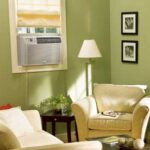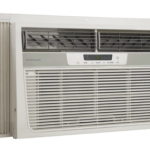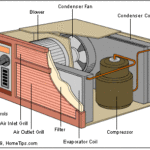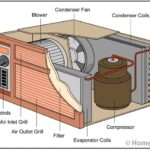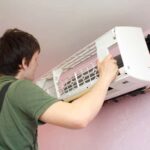Evaporative coolers, also known as “swamp coolers,” produce more effective cooling than traditional fans without the cost of air conditioning. This unbiased guide shows you how they work and how to buy the right one.
“Should we plug in a fan or turn on the AC?” As the weather warms up, this dilemma is often repeated in households across America. Late spring or early summer are often those times of year when the heat of summer can no longer be relieved with fans—and yet shifting over to air conditioning seems unnecessarily wasteful and expensive.
Evaporative coolers, as their name suggests, use evaporation—the conversion of water into water vapor—to lower ambient temperatures and achieve effective cooling. Their primary advantages are their low energy consumption, more effective cooling when compared with traditional fans, and reasonable cost. Their disadvantages are their dependency on ambient humidity and the fact that they don’t cool as effectively as air conditioners.
In this overview, we will:
- Describe how evaporative coolers work
- Explain how evaporative coolers differ from both fans and air conditioners
- Show how to best use evaporative coolers
- Help you choose the right type of cooler for your space
How Evaporative Coolers Work
Evaporative air coolers, as the name suggests, use the chemical process of evaporation to cool down hot air. To understand this, imagine a sweaty sensation on a hot summer’s day. The feeling is stifling until you stand in front of a fan, when its breeze evaporates the perspiration, leaving your body cool and dry. This works because heat energy is lost during the chemical conversion of liquid (perspiration) into water vapor.
Evaporative cooling works similarly. Most evaporative air coolers have three core components: a fan, a pump system to circulate water, and a cooling medium that absorbs and retains water. Honeycomb cooling media is commonly used in portable evaporative coolers in the US. Water circulates through the cooler and saturates the honeycomb media. The fan draws incoming warm air through the media, where evaporation converts water into water vapor and blows out colder air on the other side.
Evaporative coolers are not fans…or air conditioners
Traditional fans circulate air without affecting a temperature drop. The refreshing feel of a powerful fan is due to the sensation on your skin rather than an actual change in ambient temperature. Air conditioners, on the other hand, do lower indoor temperatures, but they require significant energy to do that job. Additionally, they use refrigerant gas to chemically condense hot air, and they maintain cooling by expelling that hot air outdoors. These factors make them a less environmentally-friendly choice.
Evaporative cooling uses a fraction of the power of air conditioning and, unlike fans, evaporative coolers also cool the surrounding area. Still, they are not air conditioners. Under testing conditions, with ideal variables, evaporative coolers have lowered temperatures by up to 15°F. Contrast that with air conditioners which have a greater cooling range. All in all, evaporative air coolers can be described as an upgrade to the traditional fan, consuming similar amounts of electricity but throwing out much cooler air through the power of evaporation.
How to Use an Evaporative Cooler
What you put in is what you get out! This motivational statement has real implications when it comes to evaporative coolers. These three variables are essential for getting the most out of an evaporative cooler:
- Ambient Air Humidity
Humidity—or rather, the lack of humidity—is the most critical element of evaporative cooling. The drier the incoming air, the greater the amount of water vapor that will be evaporated into the outgoing air, and the greater the cooling power. Evaporative coolers work best in arid or semi-arid regions that have relative humidity below 60%. Humid climates inhibit evaporation since the incoming air is already saturated with moisture.
- Unit Water Temperature
The colder the circulating water, the brisker the outgoing air. Many evaporative coolers will include an ice compartment, which you can load with ice and substantially
lower the base water temperature.
- Ventilation
For those accustomed to air conditioning, this variable tends to come as a surprise: evaporative cooling requires cross-ventilation. Evaporative coolers steadily add hydration to hot, dry air. However, if that moist air recirculates back into the unit, its efficacy will diminish. Keeping a window or door open to allow for a cross-breeze of fresh dry air is necessary for effective evaporative cooling.
Buying the Right Cooler for Your Space
Evaporative coolers come in a range of sizes and styles for inside and around the home.
- Portable Indoor Evaporative Coolers
Designed for the home, these models distinguish themselves by their compact design and easy portability. Plug one into your bedroom or roll it our into your living room. The core difference between models, aside for user-friendly features, is their CFM (Cubic Feet per Minute). A high CFM is best for large spaces. The chart below matches CFM with room size. Manufacturers such as Honeywell and SPT have a wide selection of portable evaporative coolers that are feature-rich, with models in a range of CFM to satisfy a full range of room sizes.
Browse Honeywell Evaporative Coolers on Amazon
Browse SPT Evaporative Coolers on Amazon
| Square Footage | Recommended CFM |
| Up to 250 sq. ft. | 200 to 750 CFM |
| 250 to 500 sq. ft. | 750 to 2000 CFM |
| 500 to 1,000 sq. ft. | 2000 to 4000 CFM |
| 1,000 to 2,000 sq. ft. | 4,000 to 7,500 CFM |
| Over 2,000 sq. ft. | Over 7,500 CFM |
- Portable Outdoor Evaporative Coolers
These rugged models are built to withstand the elements. Weatherproof, with some models connecting to an outdoor water supply for continuous cooling, they add a fresh breeze to your deck, patio or pool areas. Portacool offers a range of rugged and heavy-duty outdoor portable swamp coolers that are built for large open areas, perfect for outdoor events and backyard areas. Browse Portacool on Amazon
If you are looking for outdoor cooling for smaller areas on your patio or backyard, Honeywell offers a range of stylish portable outdoor coolers. The newest outdoor cooler from Honeywell has a sleek modern design while sporting a powerful blower for fast and long air throw. Designed for outdoor living, it is equipped with two beverage holders and a small storage compartment. See Honeywell’s outdoor line on Amazon.
- Whole House or Window Mounted Evaporative Coolers
This final category is the most powerful of residential evaporative coolers. They are permanently installed into the window or mounted onto the roof, are hooked up to the home’s water supply, and essentially become a complete alternative to central air. Essick Air and Champion are reliable brands for whole house/ window mounted evaporative coolers.
Shop Essick Air Evaporative Coolers
Whatever your purchase, in the right climate, evaporative cooling is an economical, eco-friendly option to cooling your home, providing you with comfort without sacrificing your wallet.
This article is courtesy of JMATEK North America
NEXT SEE:
• Buying the Best Window Air Conditioner or Room AC Unit
• Central AC Overview
• How a Central Air Conditioner Works
• Ceiling Fans Buying Guide
• How Room Air Conditioners Work



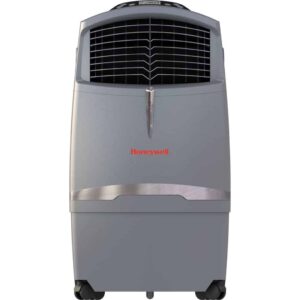
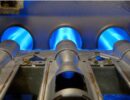



 Don Vandervort writes or edits every article at HomeTips. Don has:
Don Vandervort writes or edits every article at HomeTips. Don has:
